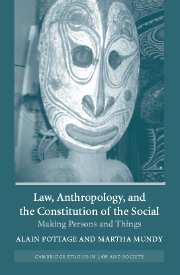Book contents
- Frontmatter
- Contents
- Notes on contributors
- 1 Introduction: the fabrication of persons and things
- 2 Res Religiosae: on the categories of religion and commerce in Roman law
- 3 Scientific objects and legal objectivity
- 4 Legal fabrications and the case of ‘cultural property’
- 5 Ownership or office? A debate in Islamic Hanafite jurisprudence over the nature of the military ‘fief’, from the Mamluks to the Ottomans
- 6 Gedik: a bundle of rights and obligations for Istanbul artisans and traders, 1750–1840
- 7 Losing (out on) intellectual resources
- 8 Re-visualising attachment: an anthropological perspective on persons and property forms
- 9 Our original inheritance
- Bibliography
- Index
2 - Res Religiosae: on the categories of religion and commerce in Roman law
Published online by Cambridge University Press: 12 July 2009
- Frontmatter
- Contents
- Notes on contributors
- 1 Introduction: the fabrication of persons and things
- 2 Res Religiosae: on the categories of religion and commerce in Roman law
- 3 Scientific objects and legal objectivity
- 4 Legal fabrications and the case of ‘cultural property’
- 5 Ownership or office? A debate in Islamic Hanafite jurisprudence over the nature of the military ‘fief’, from the Mamluks to the Ottomans
- 6 Gedik: a bundle of rights and obligations for Istanbul artisans and traders, 1750–1840
- 7 Losing (out on) intellectual resources
- 8 Re-visualising attachment: an anthropological perspective on persons and property forms
- 9 Our original inheritance
- Bibliography
- Index
Summary
Roman lawyers were often faced with the task of giving a strict definition to tombs. First, they had to define the scope of application of a law against the violation of sepulchres that had been introduced by the urban praetor. This was a rule of criminal law punishable by a pecuniary fine. It protected the funerary edifice itself, in both its tangible entirety and its external integrity. The commentaries specify, case by case, what counted as a part of the sepulchrum. The prohibition applied to any form of violence done to the monument built over the sepulchre, notably any act of breaking, removing, or displacing the stones of the tomb, its marbles, statues, or columns, or its ornamental features. These lists of materials and objects were provided in an attempt to define a very particular kind of crime, one which apprehended the profaning act by referring to the thing profaned. It was also quite common for private individuals themselves to specify in comminatory sepulchral conditions the precise extent of their tomb, using the geometric techniques of the surveyor to define its exact breadth and height. In all cases it was necessary to delimit the space of the sepulchre, either legally or geometrically, in order that it might be sanctuarised. In other words, the dead were to occupy only that space which was strictly assigned to them.
- Type
- Chapter
- Information
- Law, Anthropology, and the Constitution of the SocialMaking Persons and Things, pp. 40 - 72Publisher: Cambridge University PressPrint publication year: 2004
- 6
- Cited by



